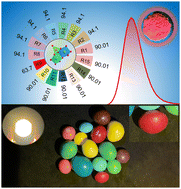Eu2+ luminescence in CaYGaO4 olivine: a new efficient red phosphor for warm illumination†
Abstract
Fine control of the photon emission of Eu2+ activated luminescent materials is essential for advanced optoelectronic applications. However, it remains difficult to design blue light excitable Eu2+ doped oxide red phosphors due to the ionicity of the oxide ions. Herein, we have mechanistically demonstrated that an Eu2+ incorporated CaYGaO4 phosphor exhibits efficient red emission at 650 nm, as a result of the Eu2+ 4f65d1 electronic state experiencing strong crystal field splitting. DFT calculations reveal that the Eu2+ ion is energetically favored in the octahedral Ca2+ site, which is responsible for the fascinating optical properties. We have also demonstrated a strategy of post thermal annealing for improving both the emission efficiency and thermal emission quenching properties of this newly developed red phosphor. By employing the as-fabricated phosphor as a red color convertor, a warm white lighting device with a high color render index of 89.7 and low corrected color temperature of 3780 K was constructed. Our findings not only provide a promising red phosphor candidate for lighting of excellent quality, but also help to stimulate new routes for designing and improving the photon emission of rare-earth luminescent materials.

- This article is part of the themed collection: Journal of Materials Chemistry C HOT Papers


 Please wait while we load your content...
Please wait while we load your content...